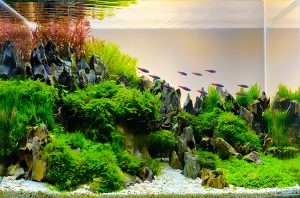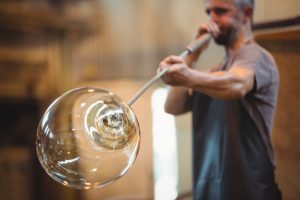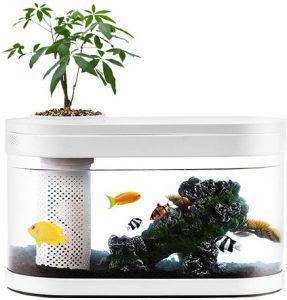
Hydroponics is an intriguing way of growing plants without using soil. Plants depend on nutrients and water for their growth, and hydroponic systems exploit these two resources in a soil-free environment. This technique has allowed hobbyists to redefine their gardening pursuits and grow plants indoors. The roots are irrigated by a continuous supply of an aqueous, nutrient-packed solution. These nutrients are added by the use of store-bought fertilizers.
When hydroponics meets aquaculture in a fish tank, you get the best of both worlds! The practice of growing plants hydroponically in aquariums eliminates the need for adding fertilizers. This is because fish provide organic nutrients that are used by plants for their growth. This sustainable combination is known as aquaponics. It is a branch of hydroponics itself, seeing how it derives the same concept with an efficient improvisation.
Hydroponics vs Aquaponics
Fewer Resources
The obvious benefit of a hydroponic system is that it takes away land from your list of worries. As a result, fewer resources are needed to grow and maintain hydroponic plants. They consume less space and have better yields compared to traditional farming methods. Another incredible relief comes from the reduction in pests and weeds since the plants are not exposed to wind and soil. This also means fewer pesticides and chemicals are used to protect the plants, making hydroponics an environmentally-friendly choice. The plant roots need to be immersed in nutrient-rich water supplied from a reservoir.
Recyclable Environments
Fish tanks make an efficient alternative for such a reservoir, turning the individual environments into one sustainable ecosystem. Therefore, aquaponics builds upon hydroponic systems by making the process completely recyclable due to its symbiotic nature. The waste products of fish break down into nutrients for the plants; these plants in turn clean up the water for the fish. So, the fish tank water will not require frequent changing, effectively cutting down future maintenance. Aquaponics also creates a lovely aesthetic for interior designs, with your favorite plants and herbs growing above the aquarium. It is like a screenshot of nature coming to life.
Additional Running Costs
Hydroponic systems incur the running cost of fertilizers to be added to the nutrient solution. On the other hand, aquaponics relies on the plant-fish-bacteria cycle. Fish waste contains ammonia, and bacteria in the water convert this into nutrients for the plants. The aquaponic plant roots absorb these natural fertilizers instead. The additional costs that aquaponic systems do incur are due to the electricity needed to oxygenate the water for the fish.
Pest Control
While pesticides can be used to control insects in hydroponic plants if necessary, aquaponic plants will need strictly chemical-free substitutes so that the fish remain unaffected.
Hydroponic fish tanks for your bucket list
Penn-Plax Aquaponic Betta Fish Tank Promotes Healthy Environment for Plants and Fish
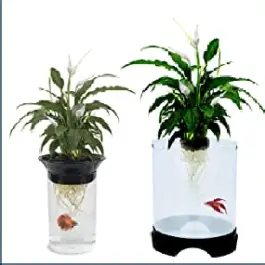
Penn-Plax aquaponic fish tank is designed to mimic a sustainable habitat for fishes like betta and goldfish. The aquaponics system allows fish waste to be recycled into plant fertilizer, and the plant in turn filters the fishbowl water to keep it safe for the fish. Your choice of fish can coexist in this aquaponic tank with various houseplants and herbs, such as peace lily, bamboo, dumb cane, mint, and chives. Ceramic substrate planting material helps with water retention and root growth in the plastic tank.
The compact and minimalistic design makes it very conducive to classroom learning in school projects. So, Penn-Plax fish tank serves aesthetic as well as educational functions. The set is available in two capacities of 0.5 and 1.4 gallons.
It is recommended to check for plant toxicity to prevent the fish from being harmed by the roots, which also require trimming, so the fish does not get tangled in them. The tank can be used as a standalone hydroponic plant bowl or just a fish tank as well. This is because the confined space can be crowded by the growing roots, depriving the fish of enough room to swim. Moreover, a lack of oxygen can be a serious concern when new leaves and roots emerge to block the surface.
AquaSprouts Garden
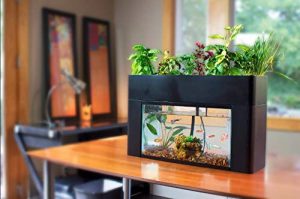
AquaSprouts self-sustaining kit is compatible with 10-gallon aquariums. Specialized teaching materials are available to allow students to explore the symbiotic interaction between plants and fishes. It gives a glimpse into the intricate balance of natural ecosystems. AquaSprouts Garden adds versatility to any interior design, whether it is your home, office, café, or school.
Various greens and herbs can be grown throughout the year. This countertop aquaponic garden brings a bit of nature indoors and creates colorful, organic vibes. For gardening enthusiasts, this home aquaponics system is an efficient choice that fertilizes their favorite plants and simultaneously purifies the tank water for pet fishes. Glow fish, shrimp, and bettas thrive well in the environment, and you can grow spinach, basil, lettuce, and other greens sustainably.
The grow-bed is easily detachable and contains clay pebbles. The clay grow media provide the surface for bacterial colonies to grow and trap the waste products, effectively turning the grow-bed into a mechanical and biological filter. Waste from the fish releases ammonia that the bacteria turn into essential nutrients for the plants, and clean water recycles back into the tank. This also means that you no longer need a filter device to clean the aquarium.
The black matte AquaSprouts Garden can be assembled without any tools. An overhead light bar attachment supports plant photosynthesis, allowing home aquaponic gardening to become even easier. You do need to attach your own light source. The kit also has a submersible pump and timer that can be set at various intervals.
Penn-Plax Presents The AquaTerrium Planting Tank – Grow Plants and Fish in one Environment
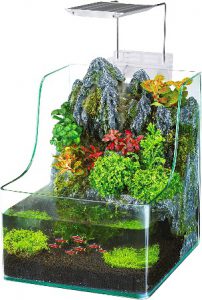
Penn-Plax AquaTerrium system combines the fish aquarium with plant terrarium into one curved glass tank. The system is equipped with integrated filtration to clean the water, and an LED plant grow light helps the plants to photosynthesize. The built-in pump circulates water in a regular hydroponic cycle that fertilizes the plants while leaving clean water behind. A rockscape waterfall delivers water and nutrients to the plants in a unique cascading style, allowing live plants and fish to grow in mutual coexistence. The 1.85-gallon tank comes with an artificial plant pack as well, which serves for décor purposes alone rather than hydroponic gardening. It is safe to say that the tank’s modern design helps you think outside the box – or rather, outside the tank!
This open-air frame makes a great desktop addition to any room and is compatible with watercress, herbs, ivy, and small fish species like shrimps. It is always recommended to check for plant toxicity and avoid seeds to keep the plant-fish interaction healthy. Although the filtration system is integrated into the fish tank, the filter is not within accessible reach for maintenance, as the rock landscape and plants tend to get in the way.



